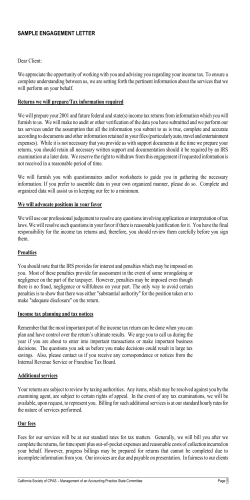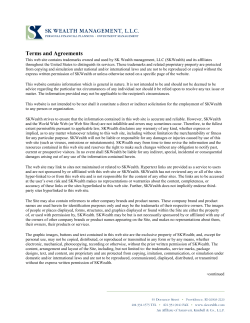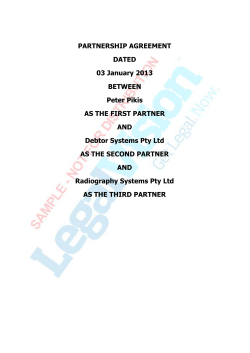
The Failure of the DMCA Notice and Takedown System: Century Problem
CENTER FOR THE PROTECTION OF INTELLECTUAL PROPERTY The Failure of the DMCA Notice and Takedown System: A Twentieth Century Solution to a Twenty-First Century Problem Bruce Boyden DECEMBER 2013 The Failure of the DMCA Notice and Takedown System: A Twentieth Century Solution to a Twenty-First Century Problem BRUCE BOYDEN Section 512 of the Digital Millennium Copyright Act will be turning 15 years old soon, and it’s showing its age. Its design belongs to a different era. Like a 15-yearold automobile, it no longer runs as well as it used to. It can’t keep up with the newer, faster vehicles on the road. Its users are beginning to look for alternative forms of transportation. Pieces of it have been wearing down over time, and ultimately something is going to break that outweighs the cost of replacement. That time may be now: the notice-and-takedown provision of Section 512 is straining under the weight of a blizzard of notices, as copyright owners struggle to abate the availability of infringing copies of their most highly valued works. The tool is no longer up to the task. Mainstream copyright owners now send takedown notices for more than 6.5 million infringing files, on over 30,000 sites, each month.1 Printing out the list of sites for which Google receives takedown requests in just one week runs to 393 pages.2 And that just counts the notices sent to Google; duplicates of many of those notices are sent to the site hosts and to other search engines. For example, over a sixmonth period ending in August, the member companies of the Motion Picture Association of America sent takedown notices for 11,996,291 files to search engines, but sent even more notices—for 13,238,860 files—directly to site operators. (See chart below.) Over a six-month period ending in August, the member companies of the Motion Picture Association of America sent takedown notices for 11,996,291 files to search engines, but sent even more notices—for 13,238,860 files—directly to site operators. Despite all the notice, there is precious little “takedown” to show for it. Unless a site employs some sort of content filtering technology, the same content typically re-appears within hours after it is removed. That amount of effort might be worth the trouble if the flurry of paperwork made more than a dent in the availability of infringing files. Despite all the notice, there is precious little “takedown” to show for it. Unless a site employs some sort of content filtering technology, the same content typically re-appears within hours after it is removed. As a result, this is a system that makes no one happy. Copyright owners are unhappy with the amount of expense and effort the system requires for such paltry results. Online services are unhappy with the burden of having to process and respond to all of those notices. Users are unhappy with inconsistent enforcement and occasional, inevitable mistakes. The problem is that notice-and-takedown has been pressed into service in a role for which it was never intended. Section 512 was originally designed as an emergency stopgap measure, to be used in isolated instances to remove infringing files from the Internet just long enough to allow a copyright owner to get into court. That design reflected the concerns of its time. In 1998, the dawn of widespread public use of the Internet, there was considerable anxiety about how the law would react to the growing problem of online infringement. Online services worried that they might be held directly liable as publishers for infringing copies of works uploaded by users, despite lacking any knowledge of those copies.3 Section 512 addressed these concerns by giving service providers a safe harbor to protect them from liability for unknowingly hosting or linking to infringing material. CENTER FOR THE PROTECTION OF INTELLECTUAL PROPERTY Section 512 was originally designed as an emergency stopgap measure, to be used in isolated instances to remove infringing files from the Internet just long enough to allow a copyright owner to get into court. Since Section 512 was a legislative compromise, Congress sought to address the concerns of copyright owners too— at least the ones they had in the late ‘90s. The problem the creative industries confronted in 1998 was one of content escapes—of copyrighted work moving off of physical formats and onto the Internet. Once there, the speed and accessibility of Internet transmission meant that even a single individual could create a website—or in the 1990s, perhaps a file transfer protocol (FTP) site—and distribute such copyrighted work worldwide. That approach suited the times. Since residential transmission speeds were slow, there was a chance that if copyrighted owners acted quickly enough they could prevent uploaded works from reaching a large audience. Even preparing court papers would take a few days, however; to get immediate results, they would need the assistance of the ISPs hosting the infringing site to help them take it down, at least temporarily. And that’s why the notice-and-takedown system was added. The goal of notice-and-takedown was to get “service providers and copyright owners to cooperate to detect and deal with” infringing sites before the content was distributed too widely.4 It was a more immediate, but temporary, substitute for going into court and getting a temporary restraining order. Indeed, it lasts approximately the same amount of time as a TRO, ten business days. The DMCA’s statutory language confirms the original, extraordinary nature of takedown requests. The notices themselves are cumbersome to draft, with six required pieces of information in a signed writing. Then, after the online service removes or disables access to the material, there is a complicated game of tennis, as the service provider must first forward the takedown notice to the user, who then may reply with a counternotice asking that the material be restored, which in turn must be forwarded back to the content owner. At that point, the copyright owner has “not less than 10, nor more than 14, business 2 days” to stop the copyrighted work from being replaced by filing a lawsuit.5 The notion that content might leak onto the Internet unless somehow stopped now seems almost quaint. Modern infringement is persistent, ubiquitous, and gargantuan in scale. It is a problem that needs to be policed, not prevented, if our current copyright system is to continue to function. Takedown notices, with their detailed requirements and elaborate back-and-forth, are a poor way to achieve the routine policing of sites that receive thousands of new files every hour. Indeed, the situation has only gotten worse. The DMCA’s unsuitability as a tool to manage chronic, persistent, and pervasive infringement is particularly apparent after recent decisions from the Second Circuit and Ninth Circuit that construed the duty of website owners very narrowly under Section 512.6 In those decisions, the courts largely rejected any arguments that Section 512 requires site owners to do anything more than remove the specific file identified in a takedown notice, even if a flood of takedown notices arrives all identifying the same copyrighted work, and even if the site owner has tools in place to automatically identify copyrighted work by pattern-matching.7 The result is that Section 512 takedowns have become largely ineffective for most works. Even for the largest media companies with the most resources at their disposal, attempting to purge a site of even a fraction of the highestvalue content is like trying to bail out an oil tanker with a thimble. In their effort to make their most highly soughtafter works just slightly harder to find, copyright owners are currently sending notices at an annualized rate of over 78 million infringing files. The expense of locating, identifying, and then sending a notice for that many files is so significant that even large companies must limit their efforts to only their most recent releases. And even then, despite intensive efforts targeted at the most popular Modern infringement is persistent, ubiquitous, and gargantuan in scale. It is a problem that needs to be policed, not prevented, if our current copyright system is to continue to function. The Failure of the DMCA Notice and Takedown System Section 512 Notices Sent by MPAA Companies8 March 2013 April 2013 Infringing URLs (Total) 5,136,431 URLs sent to site operators 2,369,308 Links sent to search engines 2,767,123 Counter-Notices Received (Total) Infringing URLs (Total) 4,839,709 URLs sent to site operators 1,982,213 Links sent to search engines 2,857,496 Counter-Notices Received (Total) May 2013 June 2013 July 2013 August 2013 Grand Totals 2 2 Infringing URLs (Total) 3,468,182 URLs sent to site operators 2,161,816 Links sent to search engines 1,306,366 Counter-Notices Received (Total) 0 Infringing URLs (Total) 3,378,371 URLs sent to site operators 1,888,692 Links sent to search engines 1,489,679 Counter-Notices Received (Total) 0 Infringing URLs (Total) 4,005,669 URLs sent to site operators 2,347,647 Links sent to search engines 1,658,022 Counter-Notices Received (Total) 1 Infringing URLs (Total) 4,406,789 URLs sent to site operators 2,489,184 Links sent to search engines 1,917,605 Counter-Notices Received (Total) 3 Infringing URLs (Total) 25,235,151 URLs sent to site operators (Grand Total) 13,238,860 Links sent to search engines (Grand Total) 11,996,291 Counter-Notices Received (Grand Total) 8 Attempting to purge a site of even a fraction of the highest-value content is like trying to bail out an oil tanker with a thimble. . . . Copyright owners are currently sending notices at an annualized rate of over 78 million infringing files. files, takedown notices achieve not a single day when the content is not available on the most heavily trafficked sites. That burden is falling on businesses of all sizes in every creative industry. Of the roughly 6.5 million files Google receives notices for each month from mainstream U.S. copyright owners, approximately 2.1 million are the subject of notices sent by the RIAA, and another 2 million are in notices sent by the MPAA member companies. But more than one-third of the notices received by Google are the results of efforts undertaken by other industries, such as publishing, video games, and software creators, and by smaller record labels and film and television producers. The enormous investment of effort required under the notice-and-takedown system is a waste of everyone’s resources. Worse, it may create perverse incentives. The impossibility of keeping up with new uploads means that an online service can create a site aimed at and dedicated to hosting infringing copyrighted works, comply with every takedown notice, and still benefit from the safe harbor, as long as its intent remains hidden. If the site has enough users, any popular content removed will be supplanted by new copies almost immediately. As a result of the increasing futility of takedown notices, some copyright owners and online services have begun seeking ways to avoid the notice-and-takedown system altogether. For example, several large user-generated content sites have adopted technological tools that allow copyright owners to identify their content and specify Despite intensive efforts targeted at the most popular files, takedown notices achieve not a single day when the content is not available on the most heavily trafficked sites. 3 CENTER FOR THE PROTECTION OF INTELLECTUAL PROPERTY It’s long past time for a retooling of the notice and takedown regime. what should happen when it appears on the service provider’s system, such as blocking or ad placement. Access providers have joined with copyright owners in 4 creating the Copyright Alert System, which is an attempt to police copyright infringement by issuing the equivalent of an escalating series of speeding tickets. These private agreements and coordination efforts (what economists call “private ordering”) may be moves in the right direction, but they also indicate the increasing frustration that copyright owners and online services have with the Sisyphean nature of takedown notices. It’s long past time for a retooling of the notice and takedown regime. The Failure of the DMCA Notice and Takedown System ENDNOTES 1Based on figures available at Transparency Report: Copyright Owners, GOOGLE (Sept. 8, 2013), http://www.google. com/transparencyreport/removals/copyright/owners/?r=last-month. The numbers reported here are, if anything, conservative. They include only takedown notices sent by major U.S. copyright owners, and exclude companies that primarily produce pornography. 2 See Paul Resnikoff, Think Piracy Is Dead? Here’s One Week of Google DMCA Takedowns . . . , Digital Music News (Sept. 23, 2013), available at http://www.digitalmusicnews.com/permalink/2013/20130923takedowns. 3At least one court so held. See Playboy Enters., Inc. v. Frena, 839 F. Supp. 1552 (M.D. Fla. 1993). 4S. Rep. No. 105-190 at 20 (1998). 517 U.S.C. § 512(g)(2)(C). 6Viacom Int’l, Inc. v. YouTube, Inc., 676 F.3d 19 (2d Cir. 2012); UMG Recordings, Inc. v. Shelter Capital Partners LLC, 106 U.S.P.Q.2d 1253 (9th Cir. 2013). 7Viacom Int’l, 676 F.3d at 30-31, 41. 8Based on information provided by the MPAA. 5 CENTER FOR THE PROTECTION OF INTELLECTUAL PROPERTY ABOUT THE AUTHOR Professor Bruce Boyden is an Assistant Professor of Law at Marquette Law School. Professor Boyden teaches and writes in the areas of copyright, Internet law, privacy, legal history, and civil procedure. His scholarship focuses on the ways in which law adapts to turbulence caused by sudden changes in the technological, social, or economic landscape. Recent articles include Games and Other Uncopyrightable Systems, 18 Geo. Mason L. Rev. 439 (2011), and Constitutional Safety Valve: The Privileges or Immunities Clause and Status Regimes in a Federalist System, 62 Ala. L. Rev. 111 (2011). Prior to joining the faculty at Marquette, Professor Boyden was a visiting professor at Washington & Lee University School of Law and at Michigan State University College of Law. Before that, he was in private practice for several years with the law firm Proskauer Rose LLP, where his practice focused on copyright, digital rights management, privacy, and Internet law. Professor Boyden is a graduate of Yale Law School, where he served as Notes Editor of the Yale Law Journal and as an Editor of the Yale Journal of Law & Feminism. He received his M.A. in history from Northwestern University and his B.A., summa cum laude, from the University of Arkansas in history and philosophy. His current research focuses on the interaction between copyright and changing technology. 6 CENTER FOR THE PROTECTION OF INTELLECTUAL PROPERTY The Center for the Protection of Intellectual Property (CPIP) at George Mason University School of Law is dedicated to the scholarly analysis of intellectual property rights and the technological, commercial, and creative innovation they facilitate. Through a wide array of academic and public policy programming, including conferences, roundtables, fellowships, debates, teleforum panels, podcasts, and other events, CPIP brings together academics, policymakers, and stakeholders in the innovative and creative industries to explore foundational questions and current controversies concerning patents, copyrights, and other intellectual property rights. Ultimately, CPIP seeks to promote balanced academic discussions grounded in rigorous scholarship and to inform the public policy debates on how securing property rights in innovation and creativity is essential to a successful and flourishing economy. CENTER FOR THE PROTECTION OF INTELLECTUAL PROPERTY George Mason University School of Law 3301 Fairfax Drive Arlington, VA 22201 http://cpip.gmu.edu Check out our blog at http://cpip.gmu.edu/blog Visit us on Facebook at www.facebook.com/cpipgmu Follow us on Twitter @cpipgmu
© Copyright 2025





















